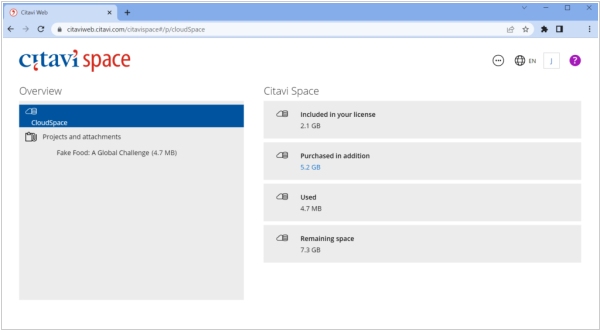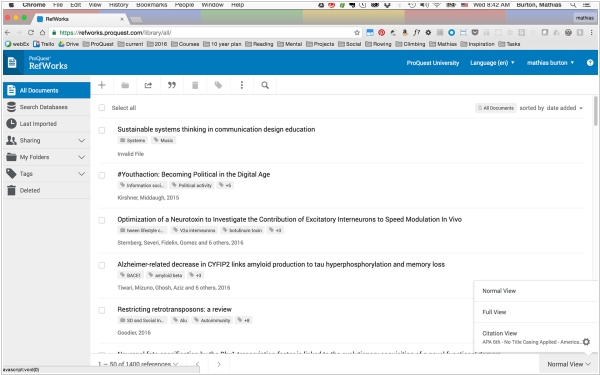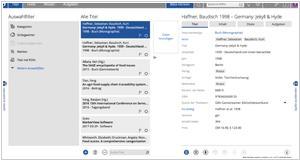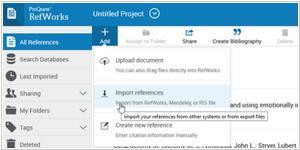Citavi vs RefWorks
Last updated: July 09, 2023
Citavi and RefWorks are both popular reference management software tools used by researchers, but they have distinct differences in terms of their features, platforms, and pricing models.
1. Features and Functionality: Citavi is a comprehensive reference management software that offers a range of features for organizing, managing, and citing references. It provides tools for importing and organizing references, creating bibliographies, and inserting citations into documents. Citavi also offers features for note-taking, task management, and full-text searching within PDF documents. It integrates with popular academic databases and libraries to facilitate efficient reference collection. RefWorks, on the other hand, focuses on cloud-based reference management. It offers features for importing and organizing references, creating bibliographies, and sharing references with collaborators. RefWorks emphasizes collaboration and offers tools for shared folders, annotation sharing, and group collaboration.
2. Platforms and Compatibility: Citavi is primarily designed for Windows and is compatible with Windows 7 and later versions. It provides a desktop application that integrates with popular word processors like Microsoft Word and LibreOffice. Citavi also offers a web version called Citavi Web, which allows users to access their references and projects from any browser. RefWorks, on the other hand, is a cloud-based solution accessible through a web browser. It is compatible with various operating systems, including Windows, macOS, and Linux. RefWorks provides platform-independent access to references and projects, enabling users to work from any device with an internet connection.
3. Pricing and Licensing: Citavi offers different licensing options, including free, individual, and team licenses. The free version of Citavi provides limited functionality and is suitable for individual users with basic reference management needs. The individual and team licenses offer additional features and support for larger projects and collaborative work. Citavi licenses are purchased with a one-time payment, providing perpetual access to the software. RefWorks, on the other hand, follows a subscription-based pricing model. It offers different subscription plans, including individual, institutional, and enterprise licenses. RefWorks subscriptions are paid on an annual or monthly basis, depending on the selected plan and user requirements.
1. Features and Functionality: Citavi is a comprehensive reference management software that offers a range of features for organizing, managing, and citing references. It provides tools for importing and organizing references, creating bibliographies, and inserting citations into documents. Citavi also offers features for note-taking, task management, and full-text searching within PDF documents. It integrates with popular academic databases and libraries to facilitate efficient reference collection. RefWorks, on the other hand, focuses on cloud-based reference management. It offers features for importing and organizing references, creating bibliographies, and sharing references with collaborators. RefWorks emphasizes collaboration and offers tools for shared folders, annotation sharing, and group collaboration.
2. Platforms and Compatibility: Citavi is primarily designed for Windows and is compatible with Windows 7 and later versions. It provides a desktop application that integrates with popular word processors like Microsoft Word and LibreOffice. Citavi also offers a web version called Citavi Web, which allows users to access their references and projects from any browser. RefWorks, on the other hand, is a cloud-based solution accessible through a web browser. It is compatible with various operating systems, including Windows, macOS, and Linux. RefWorks provides platform-independent access to references and projects, enabling users to work from any device with an internet connection.
3. Pricing and Licensing: Citavi offers different licensing options, including free, individual, and team licenses. The free version of Citavi provides limited functionality and is suitable for individual users with basic reference management needs. The individual and team licenses offer additional features and support for larger projects and collaborative work. Citavi licenses are purchased with a one-time payment, providing perpetual access to the software. RefWorks, on the other hand, follows a subscription-based pricing model. It offers different subscription plans, including individual, institutional, and enterprise licenses. RefWorks subscriptions are paid on an annual or monthly basis, depending on the selected plan and user requirements.
10
Citavi is the only reference management program for teams that gives you the option of storing your information on your own server instead of in the cloud.
8
RefWorks is a web-based commercial reference management software package. The software enables linking from a user's RefWorks account to electronic editions of journals to which the institution's library subscribes.
Citavi vs RefWorks in our news:
2022. Citavi inlines Web version with desktop's

Citation Management software Citavi has released a new version that brings the writing and knowledge management features of Citavi Web in line with Citavi for Windows, providing Mac users access to these capabilities. The Word Assistant now enables users to insert category systems, which was previously only available through the Citavi for Windows Word Add-In, making it inaccessible to Mac and Citavi Web-only users. Additionally, users can insert categorized knowledge items along with their outline, allowing them to obtain a bird's-eye view of their project and identify gaps where more research is necessary. The update also enhances the handling of knowledge items in the Citavi Assistant to achieve feature parity with the Citavi Word Add-In for Windows.
2016. ProQuest has revamped the RefWorks platform to simplify the process of research and collaboration.

ProQuest has introduced a new version of the RefWorks reference management platform, designed to simplify and enhance research and collaboration workflows for students, faculty, and librarians. The platform features a modern citation-style editor with a WYSIWYG interface, making it easier to implement customized output styles. It also includes a built-in PDF reader with annotation and collaboration capabilities, enabling individuals and teams to work more effectively within and outside their institution. The platform offers sharing controls that allow libraries to manage full-text content within the platform, ensuring compliance with copyright obligations. Additionally, new add-ins for Microsoft Store for Office 2016 and Google Docs eliminate the need for traditional downloads, giving students more flexibility in their writing environments. The platform leverages the proprietary 2.6 billion record Summon® discovery service index to validate, correct, and enhance citations, making research more efficient.


